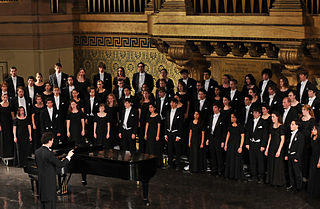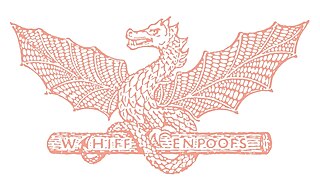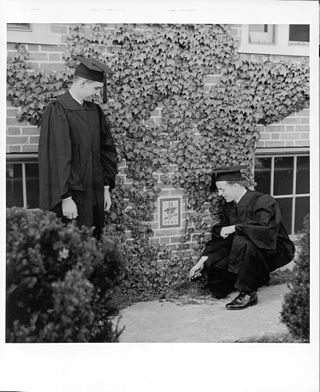
Yale University is a private Ivy League research university in New Haven, Connecticut. Founded in 1701, Yale is the third-oldest institution of higher education in the United States, and one of the nine colonial colleges chartered before the American Revolution.

Yale College is the undergraduate college of Yale University. Founded in 1701, it is the original school of the university. Although other Yale schools were founded as early as 1810, all of Yale was officially known as Yale College until 1887, when its schools were confederated and the institution was renamed Yale University.

The "Battle Hymn of the Republic", also known as the "Mine Eyes Have Seen the Glory" or the "Glory, Glory Hallelujah" outside of the United States, is an American patriotic song that was written by the abolitionist writer Julia Ward Howe during the American Civil War.

The Scroll and Key Society is a secret society, founded in 1842 at Yale University, in New Haven, Connecticut. It is one of the oldest Yale secret societies and reputedly the wealthiest. The society is one of the reputed "Big Three" societies at Yale, along with Skull and Bones and Wolf's Head. Each spring the society admits 15 rising seniors to participate in its activities and carry on its traditions.

Elihu Club or Elihu is the fourth oldest senior society at Yale University, New Haven, CT. It was founded in 1903 and takes its name from Elihu Yale.

Collegiate a cappella ensembles are college-affiliated singing groups, primarily in the United States, and, increasingly, the United Kingdom and Ireland, that perform entirely without musical instruments. The groups are typically composed of, operated by, and directed by students. In the context of collegiate a cappella, the term a cappella typically also refers to the music genre performed by pop-centric student singing groups. Consequently, an ensemble that sings unaccompanied classical music may not be considered an a cappella group, even though technically it is performing a cappella.

The Yale Glee Club is a mixed chorus of men and women, consisting of students of Yale University in New Haven, Connecticut. Founded in 1861, it is the third oldest collegiate chorus in the United States after the Harvard Glee Club, founded in 1858, and the University of Michigan Men's Glee Club, founded in 1859. The Glee Club performs several concerts each year in New Haven and goes on tour each January. According to music critic Zachary Woolfe of the New York Times, it is "one of the best collegiate singing ensembles, and one of the most adventurous." Its members are "world famous for their harmonic precision" per New York Times music critic Robert Sherman.

The Spizzwinks, stylized as The Spizzwinks(?), are an a cappella singing group of undergraduates from Yale University. Founded in late 1913, the Spizzwinks(?) are the oldest underclassman a cappella group in the United States, dating back to a first performance in early 1914.
"Glory Glory" is a terrace chant sung in association football in the United Kingdom and in other sport. It uses a popular camp meeting hymn tune of unknown origin that is famously associated with the marching song "John Brown's Body", with the chorus "Glory, Glory, Hallelujah" – the chant replaces "Hallelujah" with the name of the favoured team. The chant's popularity has caused several clubs to release their version as an official team song.
The Princeton Nassoons are a ten to twenty-member low-voice a cappella group at Princeton University. The group has been officially self-selecting since 1941, although the original group is known to have sung together as early as 1939. The Nassoons are the oldest a cappella group at Princeton University.

"Leeds! Leeds! Leeds!" is the name of the anthem of Leeds United written by Les Reed and Barry Mason. The vocals on the original recording were sung by the 1972 team members of the Leeds United and their supporters. The record stayed in the UK Singles Chart for almost three months, peaking at number 10.

The Yale Whiffenpoofs is a collegiate a cappella singing group at Yale University. Established in 1909, it is the oldest such group in the United States. Best known for "The Whiffenpoof Song", the group is composed of 14 senior students who compete for admission in the spring of their junior year. Former members include Cole Porter and Jonathan Coulton.
George Gaddis Smith was an American historian who was the Larned Professor Emeritus of History at Yale University and an expert on U.S. foreign relations and maritime history.

Edward Harris Coy was an American football player and coach. Coy was selected as a first-team All-American three straight years from 1907 to 1909 and was later selected as the fullback on Walter Camp's All-Time All-America team. He also served as Yale's head football coach in 1910. In 1951, Coy was inducted into the College Football Hall of Fame as part of its inaugural class.
"Bright College Years" is one of the traditional songs of Yale University, and the university's unofficial but undisputed alma mater. It was written in 1881 by Henry Durand and set to the tune of "Die Wacht am Rhein".

The Yankee Doodle Coffee Shop, also known as The Doodle, was a diner in New Haven, Connecticut that catered to the Yale University community for 58 years before closing on January 28, 2008. The narrow restaurant, with only 12 stools arranged opposite a counter that ran the length of shop, was a favorite among students, faculty, and employees of the university. Bill Clinton, George W. Bush, and Henry Winkler are said to have been regulars during their times at Yale. The Doodle was known for its cheap but excellent food, especially the fried donut—an old fashioned donut cut down the middle, buttered, fried on the grill, and then re-buttered before serving. Other unique items popular with students included; the Bacon Egg and Cheese "No Break," The Doodle Dandy, and a variety of grilled muffins.
"Boola Boola" is a football song of Yale University. It has enjoyed widespread popularity over the years and has been adapted to many other uses. Despite its popularity, it is not Yale's official fight song, which is "Bull Dog", by Cole Porter.

The Society of Orpheus and Bacchus, also known as the SOBs, is an a cappella singing group from Yale University. Founded in 1938, The Society of Orpheus and Bacchus is the second longest continuously running underclassmen a cappella group in the United States. Alumni of the SOBs have gone on to be founding members of other college a cappella groups such as The Pitchforks of Duke University and The Chorallaries of MIT.
Poor Little Lambs is a play by Paul Rudnick. It was first produced at the Theater at St. Peter's Church in the Citicorp Center in Manhattan, New York City, in 1982. The 1982 production, which featured David Naughton of An American Werewolf in London fame, is notable for including in its cast a number of young actors who were beginning to achieve, or later achieved, significant success in television or movies, including Kevin Bacon, Gedde Watanabe and Bronson Pinchot.

The traditions of Bates College include the activities, songs, and academic regalia of Bates College, a private liberal arts college in Lewiston, Maine. They are well known on campus and nationally as an embedded component of the student life at the college and its history.

















